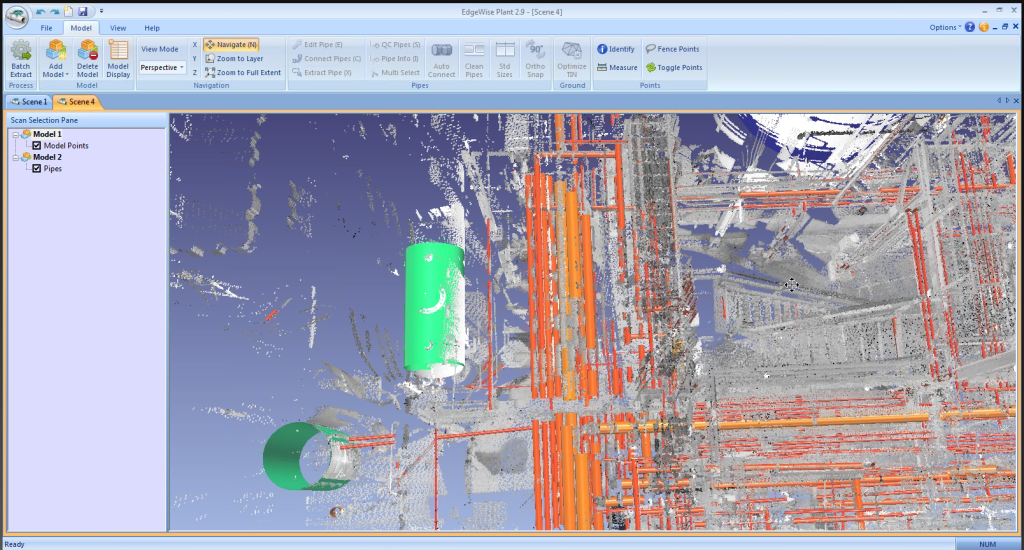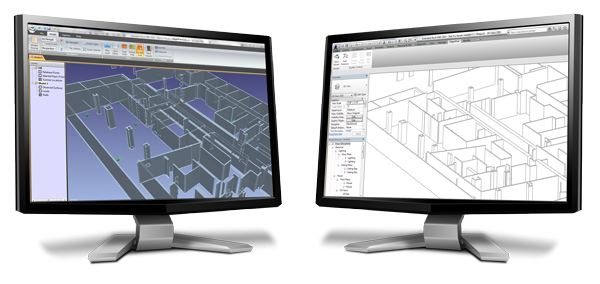Anytime the word “auto” is used to reference a task, excitement flows through the air. The hope is that this automation will be a “cure-all” and save time and money.
Auto extraction of information from point clouds certainly achieves this; however, it’s important to remember that at this point in time auto extraction is not a process that will extract 100% of the necessary information from a point cloud. It is a process that will probably extract about 30% of the information and the other 70% still needs to be extracted by hand. That being said, you are still saving 30% of your time and 30% of your money by using auto extraction.
While point cloud data can be collected relatively quickly compared to other survey methods,this data still needs to then be translated into BIM for real world use. The dots frequently need to be “connected,” so to speak, to make the information usable for the AEC industry. Reading and creating a model from this information is referred to as “extraction.” The majority of this process is still done by skilled workers who build the geometry from the point cloud. By combining the skills of these workers with an auto extraction software package, you get quite an efficient duo.
Meshing
Meshing refers to the ability to extract polygon or triangular meshes through a series of algorithms that recognize volumetric distances and alpha shapes. What this means in layman’s terms is that the software looks for specific dot patterns and then connects them into a plane. Some software packages can handle “NURBS” surfaces, which are very complex irregular shapes like human faces, machine parts, cars, etc. Meshing has been utilized in the entertainment industry for the past two decades to properly make organic forms in computer graphics or fit actors for costumes and props.

Meshing of surfaces has been used in the entertainment industry for decades. This is an example of very fine meshing used to create a digital double of Mark Ruffalo for The Hulk.
However, for the AEC industry, auto extraction of surfaces by connecting dots and creating millions of polygons is frequently not efficient. To work with such a model you need a very powerful computer and it the final model will not have any intelligence built in. Meaning, there is no distinction between a wall surface, or a floor surface. And a door will be part of the same geometry as the wall.
In the AEC field, meshing is used predominantly for extracting large surfaces, such as an irregular roofs, parking lots or topography. Meshing such expansive, irregular surfaces is significantly faster and more accurate than trying to do this by hand in a CAD program.
Category-Based Extraction
A different type of auto extraction has recently emerged that is specifically designed to meet the needs of the AEC industry. This type of extraction is based on categories of objects. Such software will go through a point cloud in phases, looking for dot patterns that fit different types of criteria.
In one phase it will go through attempting to find all cylindrical objects that are of a specified size range. In this phase it is looking for pipes. In the next phase it will go through and identify all dot patterns that are vertical rectangles of a specified dimension range. In this phase it is looking for columns. Each phase has it’s own algorithm that describes a specific type of object, and each phase puts the extracted geometry on a different layer giving the model more “intelligence.”

In this phase, dot patterns that match the pipes algorithm are being converted to geometry. This is a screen shot from an auto extraction software Lanmar utilizes called EdgeWise.

Here the dot patterns matching the walls algorithm have been extracted. This information can be imported into Revit under the wall category.
Additional Resources:
- Rusinkiewicz, S. and Levoy, M. ,2000: a multiresolution point rendering system for large meshes.(http://doi.acm.org/10.1145/344779.344940)-New York, NY
- K. Hammoudi, F. Dornaika, B. Soheilian, N. Paparoditis., 1–3 September 2010. Extracting Wire-frame Models of Street Facades from 3D Point Clouds and the Corresponding Cadastral Map. International Archives of Photogrammetry, Remote Sensing and Spatial Information Sciences (IAPRS), vol. 38, part 3A, pp. 91–96, Saint-Mandé, France
- Pu, Shi., 2007: Automatic building modeling from terrestrial laser scanning(http://www.itc.nl/personal/pushi/docs/automatic2007.pdf)- Enschede, the Netherlands
- Ramshaw, Lyle,. 1987: Blossoming: A connect the dots approach to splines(http://www.hpl.hp.com/techreports/Compaq-DEC/SRC-RR-19.pdf)- Palo Alto, CA
- Page, Scott,. 2012: 3D Laser Scanning: As Built Capture for BIM(http://www.aecbytes.com/viewpoint/2012/issue_66.html) – U.C. Berkeley, CA
